KEY TAKEAWAYS
- The study aimed to assess fraxetin’s anti-AML impact via cell experiments and network pharmacology analysis.
- The findings indicated that fraxetin may inhibit AML cell proliferation and induce apoptosis via multiple targets and pathways.
Prior research has demonstrated fraxetin’s antitumor efficacy across various cancer types, yet its impact on acute myeloid leukemia (AML) remains uncertain.
Tingting Fang and the team aimed to assess fraxetin’s anti-AML effect via cell experiments and network pharmacology analysis.
The inhibitory and apoptotic effects of fraxetin on AML cells were assessed using CCK-8 and flow cytometry experiments. Public databases were utilized to screen for potential fraxetin targets and AML-related targets.
PPI network, GO functional enrichment, and KEGG pathway enrichment analyses were conducted to identify hub targets and signaling pathways involved in fraxetin’s effect on AML. Molecular docking was employed to determine fraxetin binding sites on hub targets. The GEPIA database was used to analyze the expression of hub targets in relation to the overall survival of patients with AML.
The results revealed that cell experiments demonstrated fraxetin’s ability to inhibit AML cell proliferation and induce apoptosis. To investigate the potential mechanisms, 29 shared targets of fraxetin and AML were identified through screening online public databases.
Among these, AKT1, TNF, and SRC were found to be related to AML cell apoptosis. The expression levels of SRC, NOS3, VAV1, LYN, and PTGS1 were associated with overall survival in AML patients (P< 0.05).
Enrichment analysis identified focal adhesion and the PI3K-AKT signaling pathway as the main pathways influencing AML cell proliferation and apoptosis. Hub targets of the PPI network, including AKT1, TNF, and CTNNB1, were related to AML cell proliferation and apoptosis. Molecular docking results indicated that fraxetin had good binding affinity with these hub targets.
The study concluded that fraxetin may inhibit AML cell proliferation and induce apoptosis through multiple targets, including AKT1, SRC, and EGFR, and various pathways, such as focal adhesion and the PI3K-AKT signaling pathway.
Funding was provided by the Sichuan Science and Technology Program.
Source: https://pubmed.ncbi.nlm.nih.gov/38858650/
Fang T, Liu L, Liu W. (2024). “Exploring the mechanism of fraxetin against acute myeloid leukemia through cell experiments and network pharmacology.” BMC Complement Med Ther. 2024 Jun 10;24(1):226. doi: 10.1186/s12906-024-04529-8. PMID: 38858650; PMCID: PMC11163689.



